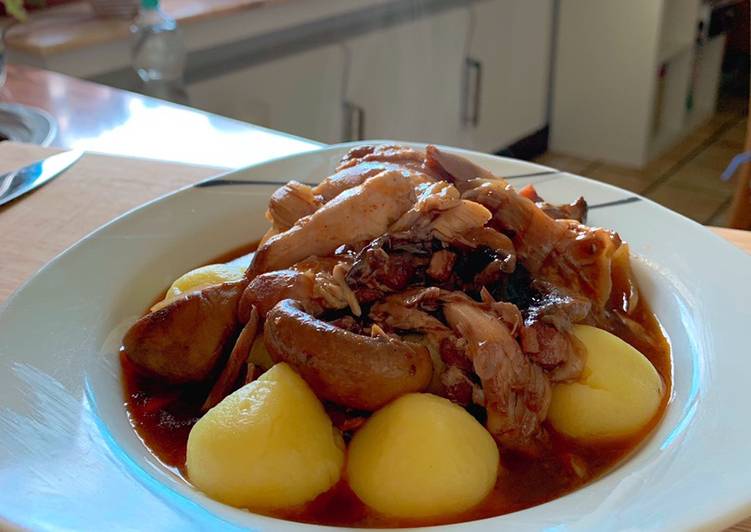 I consulted recipes from several sources to make this one.
A coq au vin is a classic French stew in which chicken is braised slowly in red wine and a little brandy to yield a supremely rich sauce filled with tender meat, crisp bits of bacon, mushrooms and burnished pearl onions Traditional recipes call for a whole cut-up chicken, but using all dark meat gives you a particularly succulent dish without the risk of overcooked white meat However, if you.
Coq au vin (/ ˌ k ɒ k oʊ ˈ v æ̃ /; French: [kɔk o vɛ̃], "rooster/cock with wine") is a French dish of chicken braised with wine, lardons, mushrooms, and optionally garlic.
I consulted recipes from several sources to make this one.
A coq au vin is a classic French stew in which chicken is braised slowly in red wine and a little brandy to yield a supremely rich sauce filled with tender meat, crisp bits of bacon, mushrooms and burnished pearl onions Traditional recipes call for a whole cut-up chicken, but using all dark meat gives you a particularly succulent dish without the risk of overcooked white meat However, if you.
Coq au vin (/ ˌ k ɒ k oʊ ˈ v æ̃ /; French: [kɔk o vɛ̃], "rooster/cock with wine") is a French dish of chicken braised with wine, lardons, mushrooms, and optionally garlic.
Zutaten von Coq au Vin
- of Gemüse.
- 100 g of Champignons.
- 100 g of Frühstücksspeck.
- 2 of große Zwiebeln.
- of Fleisch.
- 2 of Hähnchenschenkel.
- 2 of Hähnchenflügel.
- of Für die Soße.
- 400 ml of Rotwein.
- 350 ml of Geflügelbrühe.
- of Gewürze/Käuter.
- 2 Esslöffel of Tomatenmark.
- of Salz und Pfeffer.
Schritt für Schritt Coq au Vin
- Die Champignons halbieren, Frühstücksspeck in Streifen schneiden und die Zwiebeln vierteln..
- Das Gemüse mit etwas Butter in einem Bräter anbraten, danach aus dem Bräter in eine Schüssel umfüllen..
- Die Geflügelteile mit Salz und Pfeffer würzen und im Bräter anbraten..
- Tomatenmark zum Geflügel geben und kurz mit anbraten. Mit Rotwein ablöschen und anschließend die Geflügelbrühe dazu geben..
- Das Gemüse zum Fleisch in den Bräter geben und auf kleiner Stufe ca 40 Minuten köcheln lassen..
This recipe sticks very much to the original, only minorly changing the ingredients and cooking method to bring it in line with the times. While Coq au Vin (or chicken in wine) might sound fancy, it is really just a simple French chicken stew that anyone can master. It will make your house smell divine, and make you feel like you're eating something extra special, whether you make it for yourself or a table full of friends. And it's not difficult to make. Coq au vin—literally "cock (rooster) with wine" in French—was originally developed as a way to make the tough meat of an older rooster edible.
Get Latest Recipe : HOME